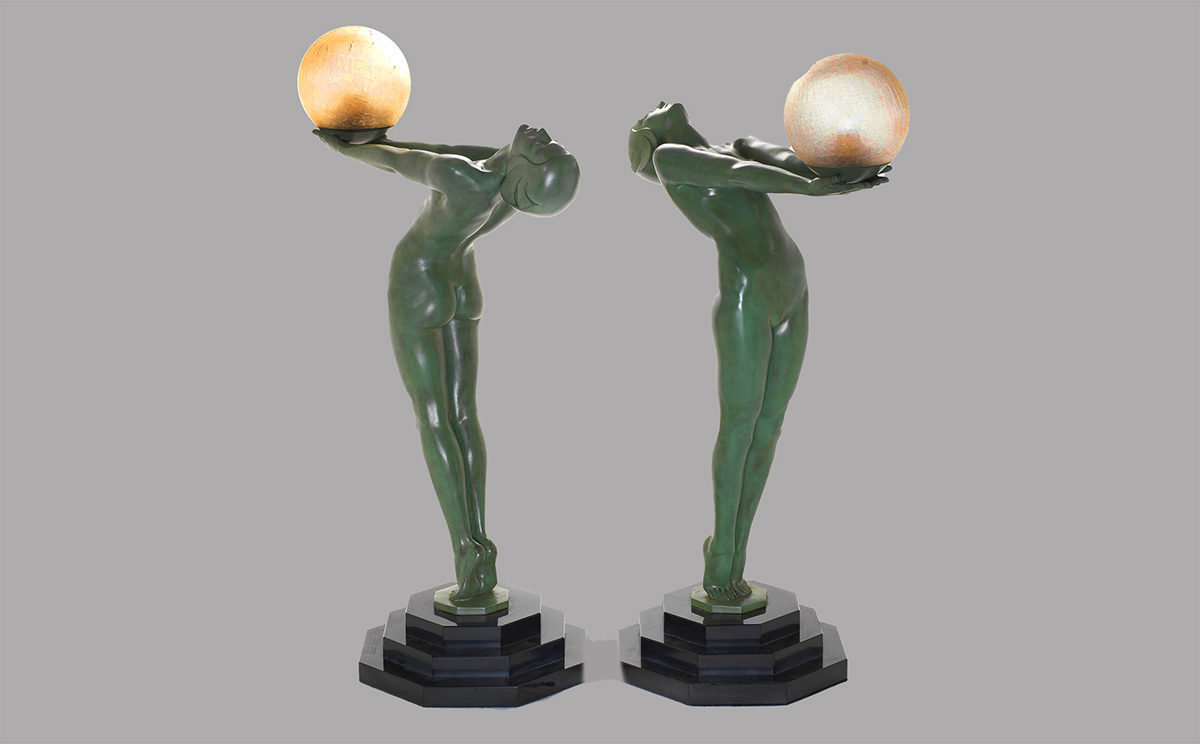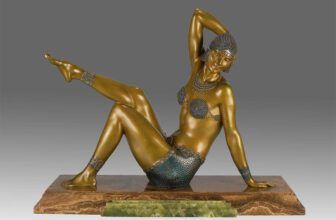
Famous Max Le Verrier Art Deco Sculptures
In the vibrant swirl of Art Deco’s rise in the early 20th century, few names shine as brightly as that of Max Le Verrier. A master of elegance, geometry, and movement, Le Verrier carved his legacy not in marble or stone, but in bronze, breathing life into sleek, stylized forms that today remain icons of a bygone yet ever-inspiring era.
Walking through the grand halls of vintage art auctions, elite Parisian galleries, or even the stately homes of collectors, the sharp-eyed observer might notice a distinct motif: sculptures of lithe women mid-dance, panthers frozen in motion, or figures poised in perfect balance. These are the works of Max Le Verrier , artist, sculptor, and master of Art Deco form.
Who Was Max Le Verrier?
Louis Octave Maxime Le Verrier, known to the world as Max Le Verrier, was born in Paris on January 29, 1891. The son of a goldsmith, he inherited an early appreciation for craftsmanship. His formal training in sculpture began at the prestigious École des Beaux-Arts in Geneva, but his artistic evolution was also deeply shaped by the devastation and rebuilding of Europe after World War I, where he served and later returned to a society eager for beauty and escape.
The 1920s in Paris were an explosion of modernism. Le Verrier entered the art scene with a vision that perfectly aligned with the ethos of Art Deco , a movement that celebrated modernity, geometry, and luxury. In 1919, he opened his own foundry and workshop, producing sculptures that would soon be recognized across Europe and beyond.
What Is Max Le Verrier Known For?
Max Le Verrier is most famous for his bronze and spelter (a zinc alloy) sculptures that epitomize the Art Deco aesthetic. His works are renowned for their graceful lines, stylized figures, and the green patinas that became a signature hallmark.
He created both decorative and functional objects: sculptures, bookends, lamp bases, wall sconces, and automobile mascots. Each piece was carefully crafted, typically cast in his own foundry, ensuring a rare degree of quality control and artistic integrity.
Le Verrier’s subjects often centered on:
Female figures , dancers, athletes, muses , often portrayed nude or semi-nude, showcasing a modern celebration of the human form.
Animals , panthers, lions, birds, and greyhounds, captured with fluid dynamism.
Mythological and allegorical themes, blending ancient stories with modern lines.
His most iconic works are unmistakably Art Deco, yet maintain a certain timelessness. They’re neither too abstract to alienate, nor too literal to feel dated.
The Most Famous Max Le Verrier Art Deco Sculptures
Over his prolific career, Le Verrier created hundreds of designs, but several stand out for their beauty, historical significance, and enduring popularity.
1. “Clarté” (also known as “The Light”)
Arguably his most famous piece, Clarté is a striking sculpture of a nude female figure holding a globe lamp above her head. The sculpture exemplifies Art Deco’s idealized form, with clean lines and a sense of upward motion. Often used as a lamp base, this piece is still widely replicated (though originals are highly prized).
“Clarté” represents enlightenment, modern womanhood, and power , themes central to the 1920s Parisian ethos.
2. “Penthesilea”
A dramatic bronze of the mythical Amazon queen, Penthesilea is depicted mid-stance with a spear, strength exuding from her sculpted form. This piece blends mythological reference with the dynamic physicality and sensuality of the female body , a perfect showcase of Le Verrier’s talent in both subject matter and execution.
3. “Seated Nude with Greyhound”
This work is a celebration of elegance and companionship. The figure , poised, calm, and symmetrical , rests beside a greyhound, an animal often associated with speed, grace, and loyalty. It’s a composition rooted in serenity and understated luxury.
4. “Danseuse au Cerceau” (Hoop Dancer)
One of his most beloved female dancer sculptures, this piece captures a young woman mid-motion, balancing inside a hoop. The pose is both athletic and poised, and the detailing of the musculature and garment folds demonstrates Le Verrier’s technical mastery.
5. Animal Sculptures
Le Verrier’s stylized panthers, cats, and birds are staples in the Art Deco animalier tradition. Their sleek lines, captured motion, and signature green or silvered patinas make them instantly recognizable.
How Did Max Le Verrier Create His Sculptures?
Le Verrier was both an artist and a craftsman. Unlike many sculptors who outsourced production, he often oversaw the entire casting process in his own foundry. This rare vertical integration ensured that his vision remained consistent from sketch to final patinated bronze.
1. Modeling the Form
Le Verrier began with sketches, then moved to clay or plaster models. These maquettes served as the basis for molds. His academic background in sculpture, combined with his flair for modern design, allowed him to straddle the worlds of classical form and avant-garde design.
2. Lost-Wax or Sand Casting
The next step was casting , often using the lost-wax method (cire perdue) or sand casting. These methods allowed for detailed reproduction of the original model into bronze or spelter.
3. Finishing Touches and Patina
Once cast, pieces were hand-chased to refine details, then given chemical patinas. The famous green patina, now synonymous with his work, was achieved through controlled chemical reactions , producing a vibrant, matte finish that enhanced the Art Deco aesthetic.
4. Functional Art
Many sculptures were designed as lamps, bookends, or automobile mascots , blending form and function, typical of the era’s decorative arts philosophy. These objects were not just for galleries; they were meant to elevate everyday living with beauty.
How Much Are Max Le Verrier Art Deco Sculptures Worth?
Le Verrier’s work varies in value based on size, rarity, condition, material, and provenance. While some small decorative pieces or later editions may sell for a few hundred dollars, original sculptures in excellent condition can fetch thousands to tens of thousands of dollars.
Estimated Value Ranges (as of recent auction data):
| Sculpture Type | Estimated Value Range |
|---|---|
| Small bookends / mascots | $500 – $2,000 |
| Medium-sized statuettes | $2,000 – $5,000 |
| Iconic lamps (e.g., “Clarté”) | $4,000 – $12,000+ |
| Large sculptures / rare editions | $10,000 – $50,000+ |
The most valuable Le Verrier pieces are original bronze castings from the 1920s–30s, particularly signed, patinated works from his own foundry.
Auction houses like Christie’s, Sotheby’s, and Artcurial often feature his work, especially in Art Deco-themed sales. Collectors prize pieces that are:
Signed (often “M. Le Verrier” or “Le Verrier”).
In excellent condition (without repair or corrosion).
With original patina and base.
Accompanied by authentic documentation.
Where Are Max Le Verrier Sculptures Located?
Today, Le Verrier’s works are found in major museums, galleries, and private collections around the world. While many pieces remain in circulation among collectors, there are key public institutions and notable locations where you can see his works:
1. France
Musée des Années Trente (Boulogne-Billancourt, near Paris): A leading Art Deco museum housing Le Verrier pieces.
Musée d’Orsay (Paris): While not always on display, they occasionally feature Le Verrier in their decorative arts exhibits.
Private Parisian galleries and auction houses often feature his work, particularly in the Saint-Germain and Marais districts.
2. United States
The Wolfsonian Museum (Miami Beach, FL): Focuses on design and decorative arts, including works by Le Verrier.
The Met (New York City): While not in the permanent display, Le Verrier works may appear in special exhibitions or be part of the decorative arts department.
Numerous art deco fairs and antique dealers in NYC, Los Angeles, and Chicago specialize in his work.
3. United Kingdom
Victoria and Albert Museum (London): As a leading design museum, it houses Art Deco pieces, sometimes including Le Verrier.
Art Deco-themed auctions in London regularly showcase his work.
4. Online and Collectors’ Markets
Platforms like 1stDibs, LiveAuctioneers, and Invaluable often list Max Le Verrier works for sale, sourced from European and American galleries.
The Legacy of Max Le Verrier
Even decades after his death in 1973, Max Le Verrier’s legacy lives on. His works capture the spirit of Art Deco , a movement driven by the desire for modernity, beauty, and elegance after the trauma of war.
Unlike artists whose fame is confined to the canvas or museum, Le Verrier brought art into the home. His sculptures weren’t just to be admired from afar , they were integrated into everyday life, turning table lamps and paperweights into fine art.
Moreover, his foundry still exists today, operated by descendants and artisans who continue to produce Le Verrier’s classic designs using original molds and techniques. These reproductions keep the tradition alive while clearly distinguishing themselves from original editions.
A Sculptor of Movement and Modernity
To own a Max Le Verrier sculpture is to hold a piece of 20th-century history , a blend of tradition and modernity, form and function. His work tells a story not only of artistic brilliance but also of resilience and reinvention in a changing world.
Max Le Verrier didn’t just sculpt bronze , he sculpted a vision. A world of grace, symmetry, and possibility, where art didn’t reside only in galleries but glowed gently from the corner of a room, radiating light, beauty, and timeless design. image/bonhams.com




